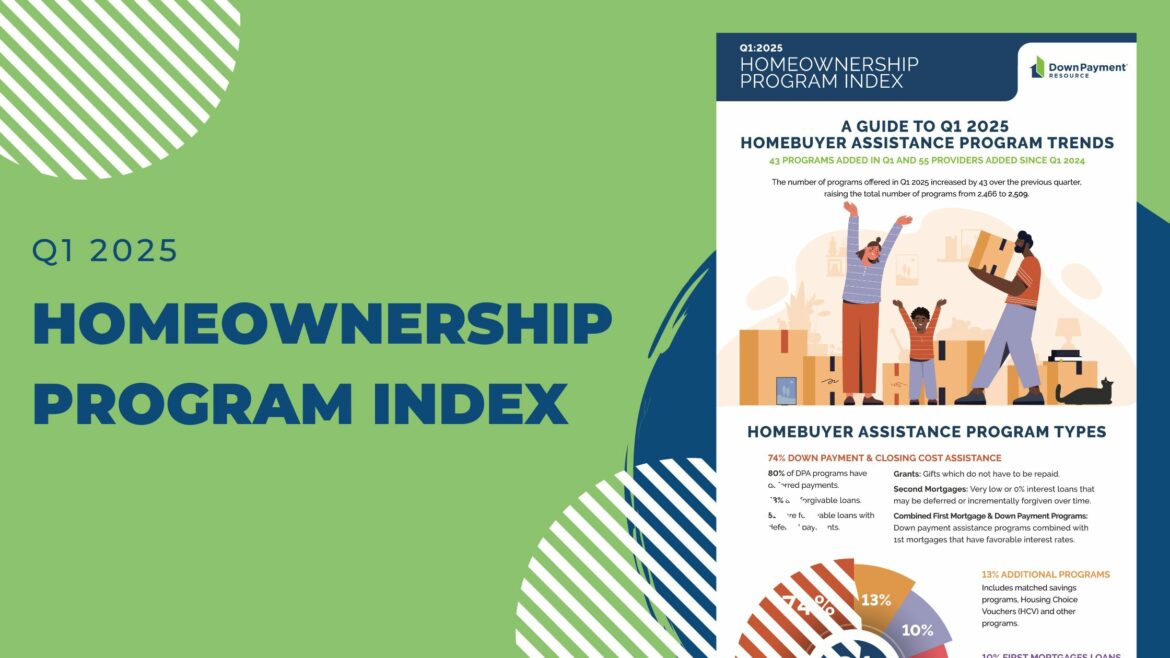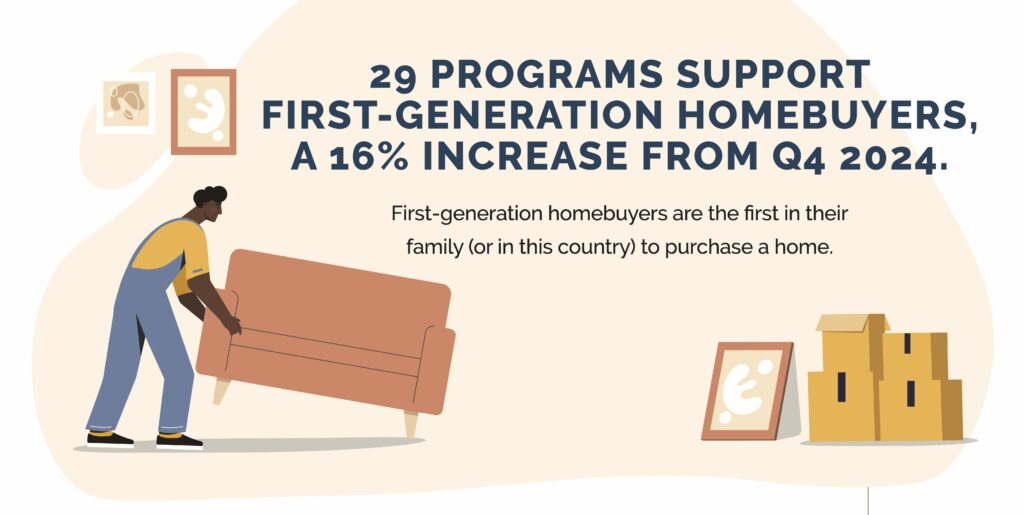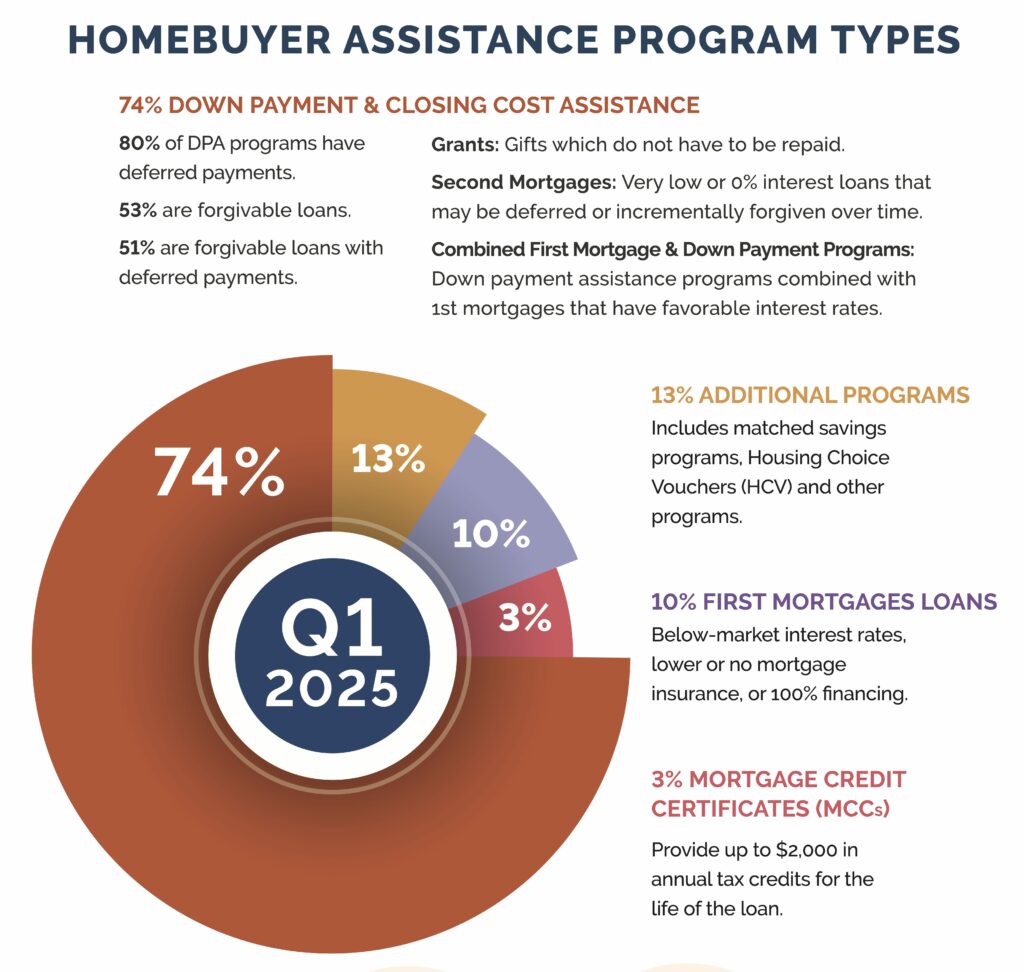
Our Holiday Tradition Changes Lives

The just-released Q1 2025 Homeownership Program Index (HPI) report from Down Payment Resource (DPR) shows a continued rise in the number of available and funded homebuyer assistance programs. 43 programs were added last quarter for a total of 2,509 – the highest number of programs DPR has recorded. Additionally, the data revealed 55 new providers have been added since Q1 2024.
Derived from our comprehensive DOWN PAYMENT RESOURCE® database, the HPI report highlights the latest trends in down payment assistance (DPA) programs. On average, these programs can lower a buyer’s LTV by 6%, helping more applicants qualify for a mortgage.
The Q1 report also shows a growing number of programs to support the purchase of manufactured and multi-family homes, allowing borrowers to access more affordable housing and housing that will provide a passive income. A total of 833 programs now support multi-family purchases, a 3% increase over Q4 2024’s 805 programs. Of these, 562 allow for 3-unit properties, up 4% from Q4 2024, while 536 allow for four-unit properties, also up 4% from the previous quarter.

Likewise, the number of programs allowing for the purchase of manufactured housing has increased from 914 in Q4 2024 to 971 in Q1 2025, a 6% increase.
The report also reveals a slight shift in program types, with other homebuyer assistance, below market rate (BMR)/resale restricted, grants, and second mortgages making quarterly gains. There was also a 3% increase in the number of local housing finance agencies offering programs, from 171 in Q4 2024 to 176 in Q1 2025.
Slightly more programs are being reserved for first-time buyers, moving from 1,518 in Q4 2024 to 1,557 in Q1 2025, a 3% increase.
The number of programs offered in Q1 2025 increased by 43 over the previous quarter, raising the total number of programs from 2,466 to 2,509.
Program spotlight: The Howard County (Maryland) Settlement/Downpayment Loan Program – HomeStarter Loan offers first-time homebuyers with a deferred loan of 10% of a home’s purchase price (up to $40,000) to assist with settlement costs. Buyers must have a minimum of $1,000 to apply toward settlement costs plus one month PITI (mortgage payment) in a savings account. Income must be 80% or less of the area median income or (AMI) based on Baltimore MSA. The maximum purchase price is $683,977, and pre-purchase counseling is required.
Program spotlight: The Alachua County SHIP Down Payment Assistance Program in Florida provides low to moderate-income (120% HUD AMI) buyers with up to $26,000 and allows for the purchase of manufactured homes. Assistance is in the form of a 10-year forgivable loan, due on sale, refinance or transfer of property, or forgiven if the borrower occupies the home for the entire term. Maximum purchase price is $250,000, and buyers must complete a SHIP-certified or equivalent homebuyer education class.

Program spotlight: The Columbia Cascade Housing Corporation 1st Generation Homebuyer Grant in Hood River, Wasco, and Sherman Counties (Oregon) provides first-generation homebuyers up to 20% of the purchase price or $60,000 in the form of a grant with no repayment required. An individual tax identification number (ITIN) is acceptable with legal status. Borrowers must have no more than $25,000 liquid assets after closing and income no higher than 100% HUD AMI. There is no maximum home purchase price.
Program Spotlight: The Atlanta Neighborhood Development Partnership, Inc. (ANDP)-FHLBank Atlanta DPA Program provides up to $20,000 in financial assistance to qualifying homebuyers with a household income of less than 80% AMI and up to $15,000 for those between 80.1-120% AMI. These funds are available on a first-come, first served basis, and can be used to purchase an ANDP home or any other existing home – including multi-family properties – in metro Atlanta.
Here is a breakdown of the homebuyer assistance programs added since Q4 2024 by assistance type:
Overall, the breakdown of homebuyer assistance programs available by type was virtually the same as the previous quarter.

A complete, state-by-state list of homebuyer assistance programs can be viewed here. You can also download the full infographic.
Down Payment Resource builds tools that help mortgage lenders, real estate agents, multiple listing services and consumer listing sites build relationships with homebuyers by connecting them with the homebuyer assistance they need.
To learn how Down Payment Resource can help you support homebuyers, contact us.
Methodology
Published quarterly, DPR’s HPI surveys the funding status, eligibility rules and benefits of U.S. homebuyer assistance programs administered by state and local housing finance agencies, municipalities, nonprofits and other housing organizations. DPR communicates with over 1,300 program providers throughout the year to track and update the country’s wide range of homeownership programs, including down payment and closing cost programs, Mortgage Credit Certificates (MCCs) and affordable first mortgages, in the DOWN PAYMENT RESOURCE® database.
